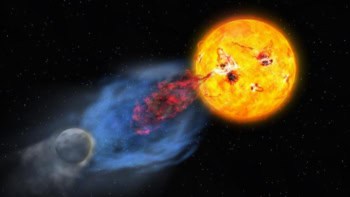
An ancient star in our galaxy’s halo harbours isotopes of barium that shouldn’t be there – at least according to our conventional understanding of nucleosynthesis. That’s the conclusion of an international team of astronomers who have spotted isotopes in a 13-billion-year-old star that should only be produced in stars that were formed later in the history of the Milky Way.
“Our observations completely contradict the theory,” says Andy Gallagher at the University of Hertfordshire in the UK. He and Sean Ryan, also at Hertfordshire, and their colleagues in the US and Japan studied a star in the constellation Libra named HD 140283. The team used data from the High Dispersion Spectrograph mounted on the Subaru Telescope in Hawaii.
Located 190 light-years from Earth, the star formed long before the explosion of other stars had given the galaxy much iron. As a result, the star’s iron content is just 1/400 that of the Sun.
HD 140283 is so old that it should not contain any barium that other stars produced via the slow process (s-process) of nucleosynthesis. This process occurs in red giant stars that convert helium into carbon and oxygen. These nuclear reactions release a slow flux of neutrons that strike a red giant’s iron nuclei, slowly transforming them into heavier elements including barium.
Too old to inherit s-process material
But it takes at least 40 million years for a star to become a red giant and cast this barium into space. Because HD 140283 is so old, it should have formed before red giants had started producing s-process barium, so the star should have inherited none.
Instead, any barium in HD 140283 should have been produced in the rapid process (r-process), which occurs when massive stars explode. Unlike red giants, massive stars die soon after their birth, so small quantities of r-process barium should have been in the gas that created HD 140283.
However, a 1995 study by Pierre Magain of the University of Liege in Belgium found that nearly all of HD 140283’s barium arose via the s-process. Later work by other astronomers said just the opposite – but now using a high-resolution, high signal-to-noise spectrum of light from the star, Gallagher’s team concludes that Magain was right after all.
Odd versus even
Gallagher and his colleagues came to this conclusion by measuring the relative abundance of the star’s barium isotopes. Two even isotopes – barium-134 and barium-136 – arise solely from the s-process, whereas three others – barium-135, barium-137 and barium-138 – arise from both the r- and s- processes. The even and odd isotopes absorb slightly different wavelengths of light, so their proportion affects the exact shape of the barium lines in the star’s spectrum.
But the effect is subtle. “I met a fellow isotope researcher,” said Gallagher, “and his comment to me was simply: ‘You poor, poor soul’.”
It’s a hideously difficult measurement Christopher Sneden, University of Texas at Austi.
“I don’t particularly like the result,” added Gallagher. “But that’s what the data suggest.”
Christopher Sneden of the University of Texas at Austin says the astronomers did a first-class job. “It’s a hideously difficult measurement,” says Sneden. “The authors have done absolutely the most thorough job I’ve ever seen anybody try on this.”
From another galaxy?
Still, Sneden says the result may not be so puzzling. He says the early galaxy was probably patchy. This star may have formed in a part of the galaxy that happened to be fairly free from supernova debris rich in r-process barium. In addition, it may have garnered its s-process material from gas enriched by a passing red giant. Gallagher says the star may even have come from another galaxy.
In any event, HD 140283 is no stranger to controversy. In 1951 American astronomers Joseph W Chamberlain and Lawrence Aller found that it and another halo star, HD 19445, had 1/100 of the Sun’s iron abundance – a finding so radical it never got published because at the time astronomers thought all stars had the same composition.
Instead, under pressure from the referee, Chamberlain and Aller moderated their claim, saying instead that the stars had 1/10 of the Sun’s iron content. As we now know, the original figure was closer to the truth.
Gallagher’s team will publish their work in Astronomy and Astrophysics. A preprint is available at arXiv: 1008.3541.



